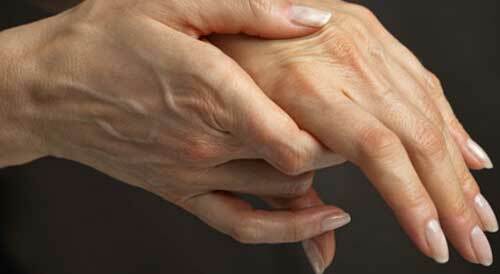What is it?
Periostitis is the process of inflammation of the periosteum( a structure of connective tissue that completely envelops the bone).The inflammatory process begins on the surface of the periosteum and then spreads inward. Bone tissue is also susceptible to inflammation, and in the absence of treatment, the disease can smoothly change into osteoperiostitis.
The code that denotes periostitis in μb 10: K10.2.The disease is localized in various parts of the body and has several forms: acute, purulent, chronic and multiple. Symptoms and manifestations differ depending on the site of inflammation of the periosteum.
The causes of periostitis are of different nature:
- Consequences of injuries associated with bones and tendons: sprains, ruptures, fractures of any type, joint dislocations;
- Spread of inflammation from a number of existing tissues: mucous membrane, skin, articular tissues;
- Local toxic infection of the periosteum or intoxication of the whole organism;
- Local effect of allergens on connective tissue;
- Rheumatic diseases;
- Consequences of tuberculosis, syphilis, actinomycosis and so on.
Content
- 1 Forms of periodontitis and localization
- 1.1 Periostitis jaw( tooth)
- 1.2 Periostitis feet
- 1.3 Periostitis nose
- 1.4 Periostitis
- 2 eyes Periostitis the child
- 3 Treatment of periodontitis, drugs
- 4 Complications
Forms of periodontitis and localization
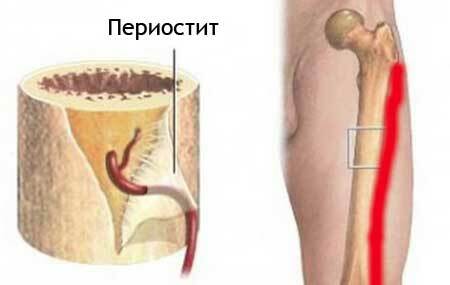
photo diagram
The periostitis can manifest itself in different ways, depending on the type and place of inflammation, and is classified into four varieties:
- Aseptic - swelling without clear edges, characterized by a verynennymi sensations with pressure, temperature increases in the inflammatory site. If the bones of the legs are affected, then lameness is observed. However, the main difference of this form is that the cause is not a microbial agent. Most often it is an allergic reaction from the periosteum or its damage in case of diffuse pathologies of connective tissue.
- Fibrous - the swelling is delineated, but the patient does not have any pain, even when touching. The inflammation itself is dense, and the mucous membrane or skin above it is mobile. At the heart of this condition is the pathological proliferation of collagen in response to an inflammatory response.
- Ossifying - swelling is very sharply outlined and characterized by a solid, heterogeneous, uneven consistency. In response to inflammation, a pathological proliferation of defective bone tissue occurs.
- Purulent - swelling is very painful, puffiness is observed in surrounding tissues. The body temperature rises, the patient feels unwell, depressed and depressed, quickly gets tired. At this form, the phenomena of intoxication are very pronounced.it is caused by pyogenic( pyogenic) bacteria.
Periostitis of the jaw( tooth)
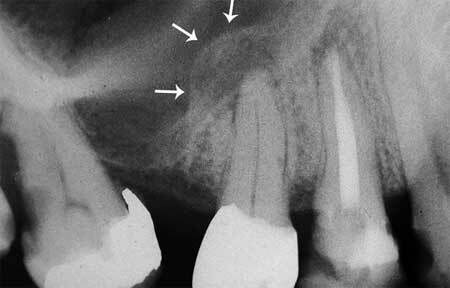
In the oral cavity, acute purulent periostitis of the jaw is often observed, which is caused by jaw bone injuries due to teething, dental treatment, infection. Also, the cause of the disease can be periodontitis and periodontitis. Catalyst of inflammation can become stressful situations, hypothermia, overfatigue and decreased immunity.
Acute periostitis assumes an abundant release of purulent masses from the focus of inflammation, therefore a swelling is formed in the periosteum. Initially, pain is not very pronounced, but after 1-3 days the pain intensifies and spreads to the entire jaw, gives the temple, eye, ear.
The area around the tooth may not be sensitive to pain. Due to the active inflammatory process, a temperature increase of 39 degrees is observed.
The tissue of the periosteum loosens, puffiness builds up, in the inflammatory cavities a serous substance( exudate) is formed, which soon becomes purulent. So the abscess is formed, and pus in severe cases can penetrate the periosteum, provoking more serious pathological changes.
Otherwise, the abscess can find a way out by itself or destroy the dental crown, roots and tooth fillings. The patient is difficult to take food because of the intensification of the pain reaction during the chewing process.
If the periostitis of the upper jaw is diagnosed, the edema is localized in the area of the upper lip, the wings of the nose, in rare cases on the eyelids. With inflammation of molars and premolars, the edema passes into the cheek area, the puffiness of the face and the "swimming" of the cheekbones are observed.
The periostitis of the lower jaw is characterized by swelling of the lower part of the face: the outline of the chin is lost, the area is swollen over the Adam's apple, the corners of the lips are lowered, the lower lip is enlarged and also descends. At this type of disease, chewing food is especially difficult, because the edema extends to the medial and chewing muscles. Lymph nodes increase, in severe cases spikes are formed.
Abscess from the area of the sky and gums can go to the surface of the tongue, then there is a through inflammation in which pus accumulates. In rare cases, the patient has a periostitis of the salivary glands surrounding the lower jaw.
The presence of cysts in the saliva of yellowish dense impurities is determined. Acute periostitis is characterized by the appearance of purulent substances within 3-4 days after inflammation.
Periostitis of the legs
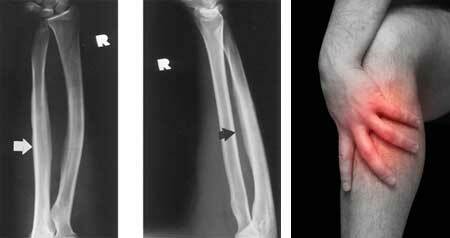
Periodontitis of the bones on the legs, as a rule, is especially frequent in athletes, whose activities are associated with active running. Systematic preparation of non-severe injuries: stretching, light dislocations, bruises, leads to seals in the bone tissue.
- The most common diagnosis is periostitis of the tibia, which is maximally susceptible to various stresses during physical training.
The tibia of the tibia is very sensitive;highly nervous. With the development of the disease, the pain is localized in the upper part of the tibia, with palpation increases. Unpleasant sensations are caused by the inflammatory process and the formation of swelling. Diagnosis of periostitis is possible not earlier than one month after the onset of the formation of an abscess( localized accumulation of pus).
If the articular bag in the knee was injured, osteoperostitis develops - the swelling appears directly on the bone. Periostitis of the joint provokes pain during movement or even difficulty in walking.
The tissues surrounding the compaction swell and block the functionality of the knee joint, so the patient is shown surgical removal of the purulent focus.
Periodic Feet also appears due to injuries, incl.and micro-injury when wearing uncomfortable shoes. Anything that can crush, rub or overload the bone, leads to inflammation of the periosteum. Due to edema, the foot deforms, the abscess causes very painful sensations, so ordinary walking is difficult or impossible. Appears compensatory lameness, i.e.patient spares a sick foot.
Nasal congestion
Such a disease occurs after a systematic neck injury, it is often affected by athletes engaged in wrestling. There is a possibility of abscess also after prolonged inflammatory processes in the nasal sinuses.
The disease is diagnosed almost immediately, because pain syndromes during palpation of swelling in the nose can not be caused by anything other than suppuration( in mild cases it is a boil, and in severe cases - periostitis).
- There is a deformation of the nose - external in the form of humps or internal, covering the passage of the nostrils.
Spreads the eye
This is an inflammation in the periosteum of the orbit, which occurs only because of infection with pathogenic cocci microorganisms. The skin around the orbit swells, there is pain when touching. The disease in this area develops more slowly than in others - it often takes from 3 weeks to 2 months.
The periostite of the eye is dangerous due to the direct connection of the orbit to the brain( through the passing nerves and vessels).
Ocular periostitis may be secondary to acute diseases of the nasopharynx and throat: tonsillitis, SARS, measles, scarlet fever, influenza. The appearance of edema may also be due to the severe form of periostitis in the mouth and in the sinuses. The poregrass fuses with the bone, forming a dense corn.
If you do not stop this process, pus will get inside the bone and the tissues will separate, which affects the duration and type of treatment.
Periostitis in a child
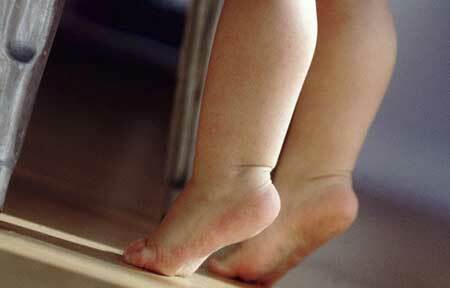
Periostitis in children can not take a chronic form and develops mainly in the mouth. The disease is caused by the growth and change of teeth, the catalyst is infection due to insufficient level of child hygiene.
To reduce risks, the child must be weaned from the habit of taking his hands and other objects contaminated with bacteria in the mouth. In rare cases, the disease occurs because of improper actions of the dentist.
With periostitis in children, lymph nodes become inflamed, as the immune system has not yet had time to get stronger. However, do not confuse the bone disease with a cold because of the similarity of symptoms.
Treatment of periostitis, preparations
Timely contact with a doctor with periostitis is considered 2-5 day after the onset of inflammation. The specialist performs a visual inspection of the abscess, and a general blood test is administered. After this, the patient is shown a radical intervention - the opening of the purulent focus and its purification.
If the swelling is localized on the mucosa, the surgeon will make a small incision under the local injection anesthesia, the procedure itself will take 20-45 minutes.
Treatment of periostitis in the mouth may require removal of the tooth around which inflammation is located. This decision is made by the doctor, depending on each specific case, there is more chance of keeping the front teeth with one root shoot. Opening of the canal and cleansing of the root must be made necessarily.
For successful treatment of bone periostitis, therapy should be comprehensive - after surgery, the patient is prescribed antiseptic, anti-inflammatory, antihistamines, as well as antibiotics and analgesics. To support the immune response of the body shows the intake of vitamins and calcium-containing drugs.
- Surgical intervention in articular tissues is rare.
The first stage of treatment of periostitis in the limbs is a set of physical exercises or massages. Overstrain and develop problem joints through pain is strictly prohibited, so as not to cause an aggravation of the pathological process.
To avoid surgery, patients are recommended warming bandages and gels. Appointed therapeutic agents aimed at remission of inflammation - these drugs Lornoxicam, Sulfadimizin, Sulfadimetoksin.
Physiotherapy after surgery includes warm baths or rinsing with antiseptic solutions. It is recommended to pass UHF and microwave therapy and treat the place with healing ointments: Levomikol, Levomizol, camphor oil, sea buckthorn and rosehip.
- Within 3-4 days after dissection, the inflammation should tangibly go down and the pain disappear.
If no positive effect is observed, the patient is shown additional infiltration of the lesion of the abscess. The heavier the case, the wider the spectrum of antibiotics is involved in the treatment of periostitis, in such cases hospitalization and daily injections are necessary within a week.
Complications of
Purulent inflammatory processes affect the general state of the body - characterized by manifestations in the form of a prolonged increase in the size of lymph nodes, intoxication, exhaustion. Problems with eating and constant pains affect the patient's morale, apathy, depression, feelings of dissatisfaction, emotional overstrain.
Complications of the periostitis of the oral cavity can be fistulous canals - this happens if the patient is severely delayed with a visit to the doctor. This is due to the fact that the purulent masses have nowhere to go, and they "are looking for another way out."
Fistula treatment requires more complex surgical intervention and prolongs the duration of rehabilitation.
If the periostitis is strongly triggered, the bone will be subject to deep destruction( destruction).Due to the penetration of the abscess into the periosteum, and then into the bone tissue, it begins to lyse and thinen. There is bone dystrophy, which interferes with the normal functioning of the musculoskeletal system.



